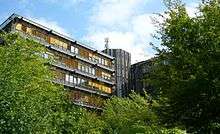University of Osnabrück
| Universität Osnabrück | |
 | |
| Latin: Universitas Osnabrugensis | |
| Type | Public |
|---|---|
| Established | 1974 |
| Budget | € 141.1 million[1] |
| President | Claus R. Rollinger |
Academic staff | 981[1] |
Administrative staff | 734[1] |
| Students | 14,000[1] |
| Location | Osnabrück, Lower Saxony, Germany |
| Campus | Urban |
| Affiliations | EUA |
| Website | www.uni-osnabrueck.de |


The University of Osnabrück (German: Universität Osnabrück) is a renowned public research university located in the city of Osnabrück in Lower Saxony, Germany.
In 2011 it was attended by 11,034 students; the staff of 1,858 consisted of 209 professors, 936 additional academic personnel (lecturers without professorships, post-doctoral researchers and post-graduate assistants) and 713 non-academic personnel.[2] The university is known for a large number of interdisciplinary degree programmes, some of them rare or even unique among German universities, including European Studies, Migration Research, Applied Systems Science and Cognitive Science. Notably, the university is well known for its research in cognitive science, peace and conflict studies, democratic governance, European Studies, Migration studies among many others.
In addition, the university, through its Master of Arts in Democratic Governance and Civil Society graduate program, is also part of the highly prestigious DAAD Public Policy and Good Governance Scholarships for Developing Countries, along with other reputable institutions in political science and public policy such as the Hertie School of Governance in Berlin and the Willy Brandt School of Public Policy in Erfurt.[3] The program attracts the best and the brightest young leaders from Asia, Latin America, and Africa to study in selected German universities for a policy-oriented Master's program.
Former President of Germany, Christian Wulff, is an alumnus of the university.
History
Higher education began in 1632 in Osnabrück when the Gymnasium Carolinum was upgraded into a Jesuit university. However, the Academia Carolina Osnabrugensis was closed just one year later when Swedish troops recaptured Osnabrück for the Protestant side in the Thirty Years' War.[4]
The government of the state of Lower Saxony decided to set up a university in Osnabrück in 1970, and by 1973 had laid down the legal basis for such an institution. The university opened for the summer semester in 1974 as a successor institution to the Adolf Reichwein Teachers' College, which had occupied the former palace of the Prince-Bishopric since 1953.
Location
The main building of Osnabrück University is the baroque castle (built 1667-1675), formerly home and office to the Prince-Bishop of Osnabrück, nowadays housing mainly university administration. It is located close to the city center. In summer, the (mostly grass-covered) castle court is used for open air cinema and concerts.
Most faculty buildings are scattered in close vicinity of the castle. Sport stadium and gymnasium are a bit farther away; the mathematical and natural-scientific faculties as well as the botanical garden are located in the western part of the city in the borough "Westerberg" (the "Western Mountain", which is rather a hill than a mountain). The campus at Westerberg is in parts shared with the neighbouring University of Applied Sciences. The distance between castle and the Westerberg campus is about 1.2 miles.
Departments and Institutes
The University of Osnabrück consists of ten schools (Fachbereiche) and four interdisciplinary institutes. Schools are split up into subjects or institutes or both.
The Schools and interdisciplinary institutes are:[5]
- School of Cultural Studies and Social Sciences
- School of Educational and Cultural Studies
- School of Physics
- School of Biology/Chemistry
- School of Mathematics/Computer Science
- School of Language and Literary Studies
- School of Human Sciences
- School of Business Administration and Economics
- School of Law
- Institute of Migration Research and Intercultural Studies
- Institute of Early Modern Intercultural Studies
- Institute of Cognitive Science
- Institute of Environmental Systems Research
See also
- Academic degree
- Education in Germany
- Fachhochschule
- List of early modern universities in Europe
- List of universities in Germany
- Osnabrück
References
- 1 2 3 4 "Zahlen/Daten/Fakten". University of Osnabrück (in German). Retrieved 2017-06-14.
- ↑ Universität Osnabrück: Zentrales Berichtswesen.
- ↑ DAAD.de.
- ↑ MacDonald, Alasdair A.; Martels,, Zweder R.W.M. von; Veenstra, Jan R., eds. (2009). Christian Humanism Essays in Honour of Arjo Vanderjagt. Leiden: Brill. p. xviii. ISBN 9789047429753.
Ere long the Jesuits made the Carolinum an important educational stronghold in the cause of the Counter-Reformation and in the middle of the seventeenth century, during the Thirty Years War, the Carolinum was raised to the status of Jesuit University. ... A year after its official opening, the university was closed down again, as the city, having the misfortune to be in the frontline between warring Protestants and Catholics, suffered the fate of repeated power changes.
- ↑ .
External links
| Wikimedia Commons has media related to University of Osnabrück. |
Coordinates: 52°16′23″N 8°02′31″E / 52.273°N 8.042°E